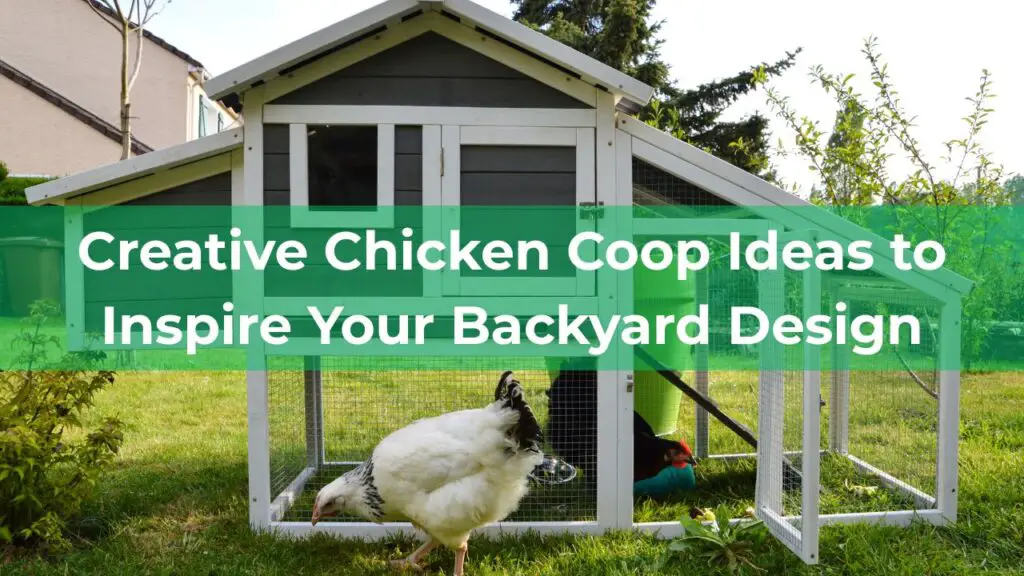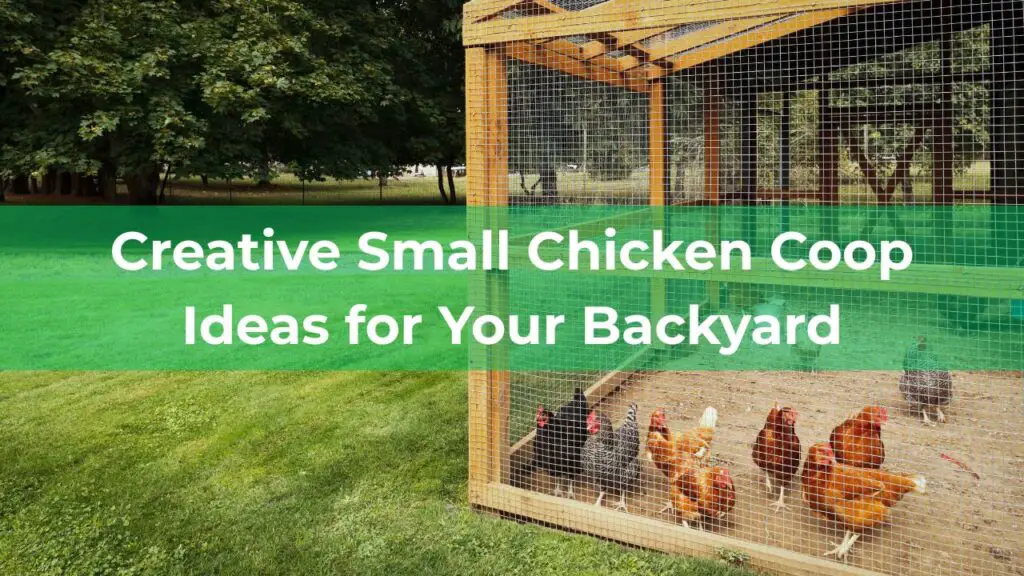Ready to spruce up your outdoor space? From cozy nooks to colorful flower beds, there are endless landscape design ideas to help you create a yard that feels just right. Whether you’re looking for inspiration or practical tips, this collection has something to spark your creativity and transform your garden into a personal getaway.
Using Native Plants for Sustainable Design
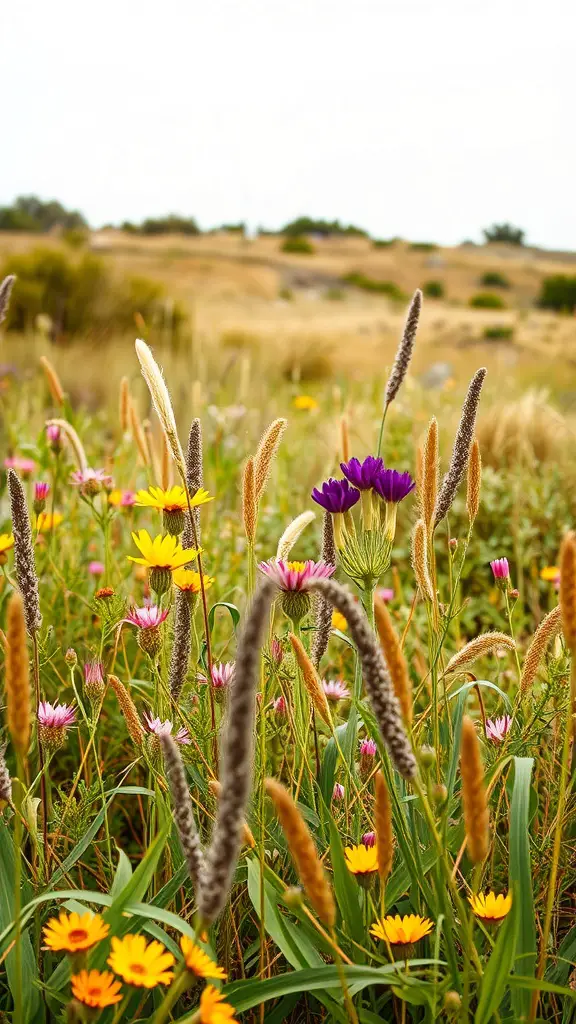
Native plants are a fantastic choice for sustainable landscape design. They thrive in local conditions and require less water and maintenance. The image showcases a vibrant mix of native flowers and grasses, creating a colorful and lively scene.
These plants attract local wildlife, such as bees and butterflies, which are essential for pollination. By incorporating them into your garden, you contribute to the local ecosystem. The variety of colors and textures in the image highlights how beautiful native plants can be.
Using native species also reduces the need for chemical fertilizers and pesticides, making your garden healthier for the environment. Plus, they can adapt to changing weather patterns, ensuring your landscape remains resilient.
Incorporating native plants into your design is not just about aesthetics; it’s about creating a sustainable space that benefits both you and the local environment. So, consider adding some of these lovely plants to your next landscaping project!
Creating Outdoor Living Spaces
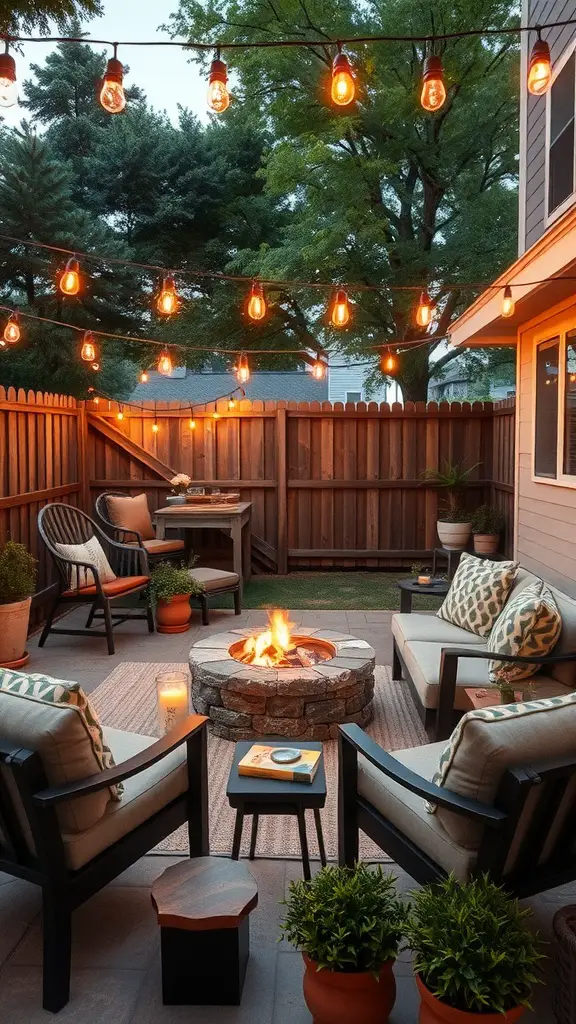
Outdoor living spaces can be a fantastic way to enjoy your backyard. The image shows a cozy setup that invites relaxation and socializing. A fire pit takes center stage, surrounded by comfortable seating. This arrangement is perfect for gatherings with friends or quiet evenings under the stars.
String lights overhead add a warm glow, creating a welcoming atmosphere. They not only provide light but also enhance the space’s charm. The natural elements, like greenery and wooden features, blend beautifully with the modern design.
Consider adding personal touches, like cushions or decorative plants, to make the space truly yours. This setup encourages you to unwind and enjoy the outdoors, making it an ideal retreat right at home.
Vertical Gardens for Small Spaces
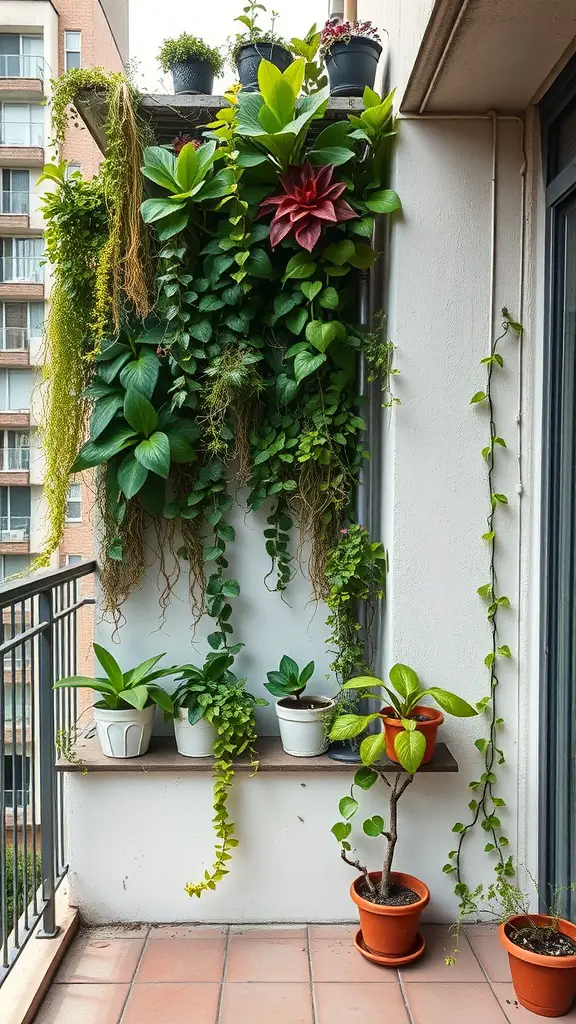
Vertical gardens are a fantastic way to bring greenery into small areas. They maximize space while adding a splash of color and life. The image shows a beautiful vertical garden setup on a balcony, showcasing a variety of plants.
The arrangement features lush green leaves cascading down, creating a vibrant backdrop. Different pots hold various plants, from trailing vines to striking blooms, making the space feel lively and inviting. This setup not only beautifies the area but also improves air quality.
For those with limited outdoor space, vertical gardens are a smart choice. They can be installed on walls, balconies, or even indoors. Using wall-mounted planters or shelves allows you to create a stunning green wall that enhances your living environment.
Consider using a mix of plants with different textures and colors for a dynamic look. Herbs, ferns, and flowering plants can all thrive in vertical gardens, giving you options to suit your style. With a little creativity, you can transform any small space into a green oasis.
Creating a Tranquil Zen Garden
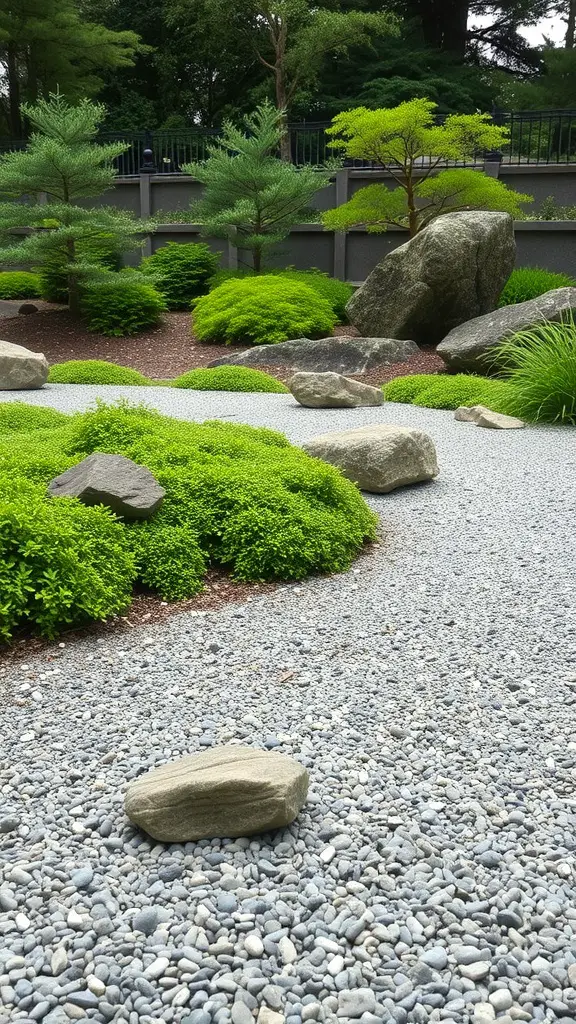
A Zen garden is a peaceful retreat that invites relaxation and reflection. The image showcases a beautifully arranged space filled with smooth stones, lush greenery, and a gentle gravel path. This setup encourages mindfulness and offers a serene escape from daily life.
The carefully placed rocks and plants create a harmonious balance. The vibrant greens of the shrubs contrast nicely with the gray pebbles, adding depth to the garden. Each element serves a purpose, guiding the eye and providing a sense of calm.
Incorporating a Zen garden into your landscape design can transform your outdoor area into a tranquil haven. Consider adding features like a small water fountain or bamboo accents to enhance the peaceful atmosphere. This space can be a perfect spot for meditation or simply enjoying nature.
Designing with Edible Landscapes in Mind
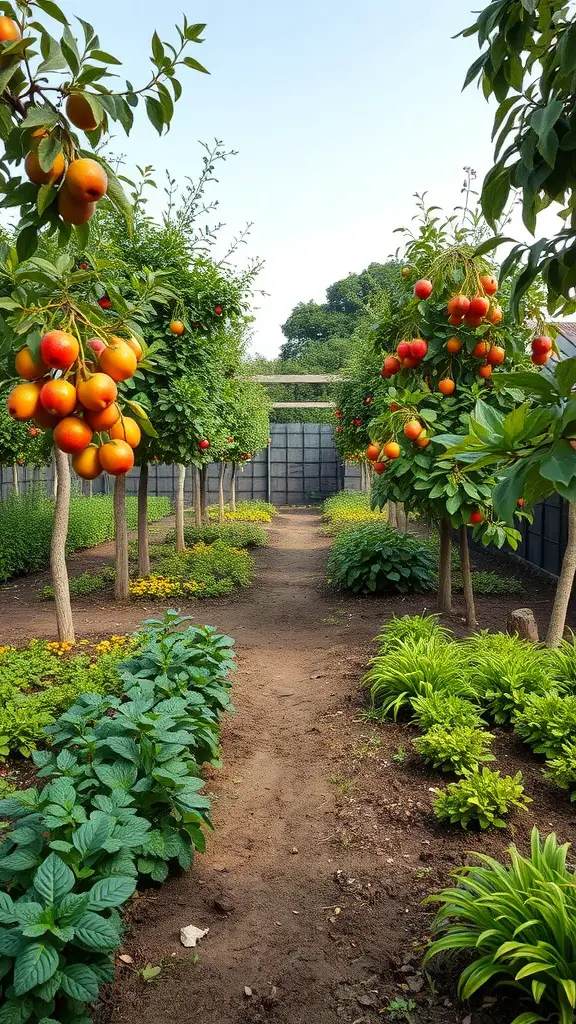
Imagine walking through a vibrant garden filled with fruit trees and lush greenery. This image captures the essence of an edible landscape, where beauty meets functionality. The neatly lined trees, heavy with ripe fruit, create a stunning visual appeal while also offering delicious treats.
Incorporating edible plants into your landscape design can transform your outdoor space. Not only do they provide fresh produce, but they also enhance the aesthetic value of your garden. The colorful fruits hanging from the trees invite you to enjoy nature’s bounty right in your backyard.
Consider planting a mix of fruit trees, herbs, and flowering plants. This combination not only attracts pollinators but also creates a diverse ecosystem. You can enjoy the sight of blooming flowers alongside the promise of juicy fruits. It’s a win-win for both your garden and your palate!
Creating pathways through your edible landscape can make it even more inviting. A simple dirt path, like the one shown in the image, encourages exploration and interaction with the plants. You can easily harvest fruits and herbs while enjoying a leisurely stroll.
Incorporating Water Features for Serenity
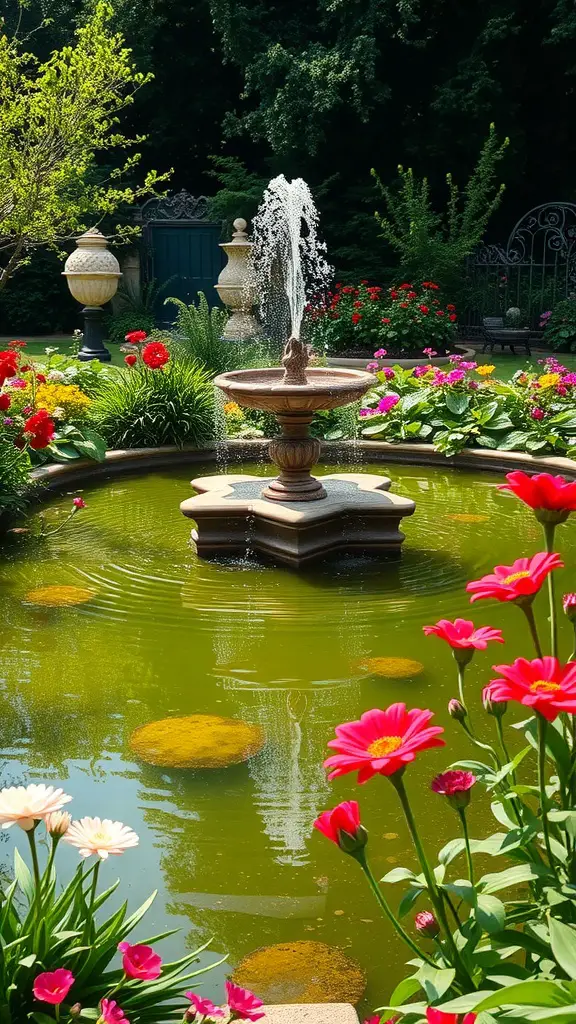
Water features can truly transform a garden into a peaceful retreat. The image showcases a charming fountain surrounded by vibrant flowers and lush greenery. This setup invites relaxation and tranquility.
The fountain serves as a focal point, drawing the eye and creating a soothing sound as water cascades down. The gentle splashes can drown out noise, making it easier to unwind. Surrounding the fountain, colorful blooms add life and joy, enhancing the overall experience.
When planning your own space, think about how a water feature can fit in. Whether it’s a small pond or a decorative fountain, the addition can elevate your garden’s appeal. Pair it with flowers that complement the water’s movement, and you’ll have a serene spot to enjoy nature.
Incorporating Paths and Walkways
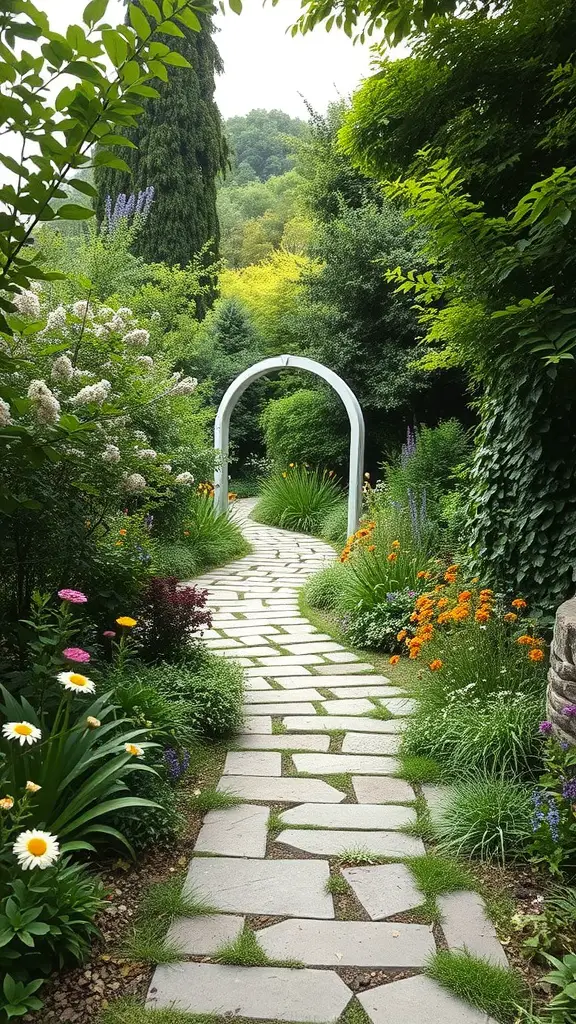
Paths and walkways are essential in any landscape design. They guide visitors through your garden, creating a sense of flow and exploration. In the image, a charming stone path winds through lush greenery and vibrant flowers, inviting you to take a stroll.
The use of natural stone adds a rustic touch, blending beautifully with the surrounding plants. Notice how the path is not just functional but also enhances the overall beauty of the space. The archway at the end creates a focal point, drawing the eye and sparking curiosity about what lies beyond.
Incorporating paths can also help define different areas in your garden. You can separate flower beds from seating areas or create a pathway to a cozy nook. This design not only improves accessibility but also adds structure to your outdoor space.
Consider using a mix of materials for your paths. Gravel, wood, or even tiles can add variety and interest. The key is to ensure that the path complements your garden’s style. A well-placed walkway can transform your landscape into a welcoming retreat.
Seasonal Color Schemes for Year-Round Appeal
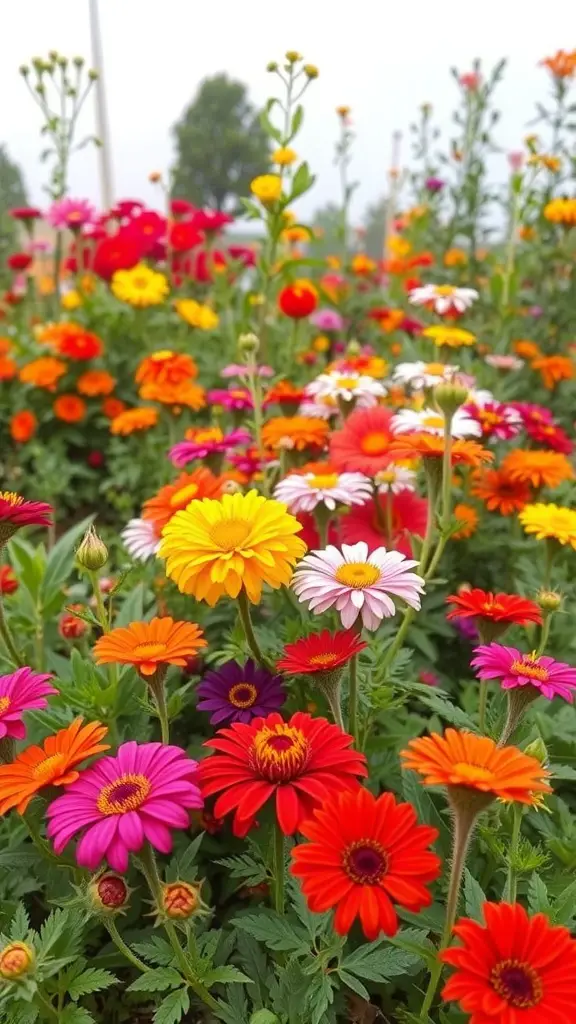
When it comes to landscape design, seasonal color schemes can make a huge difference. The image showcases a vibrant mix of flowers in shades of red, orange, pink, and yellow. This lively palette brings energy and warmth, perfect for any garden.
Choosing flowers that bloom in different seasons ensures your garden stays colorful throughout the year. For instance, early spring blooms like daffodils can be paired with summer favorites such as sunflowers. This way, you can enjoy a continuous display of color.
Incorporating a variety of textures and heights adds depth to your landscape. The flowers in the image show how layering can create a stunning visual effect. Tall blooms can stand proudly behind shorter ones, making the garden feel fuller and more inviting.
Don’t forget about foliage! Green leaves can complement bright flowers beautifully. Consider plants with different leaf shapes and colors to enhance your garden’s appeal. A well-planned seasonal color scheme can turn your outdoor space into a year-round delight.
Incorporating Lighting for Evening Ambiance
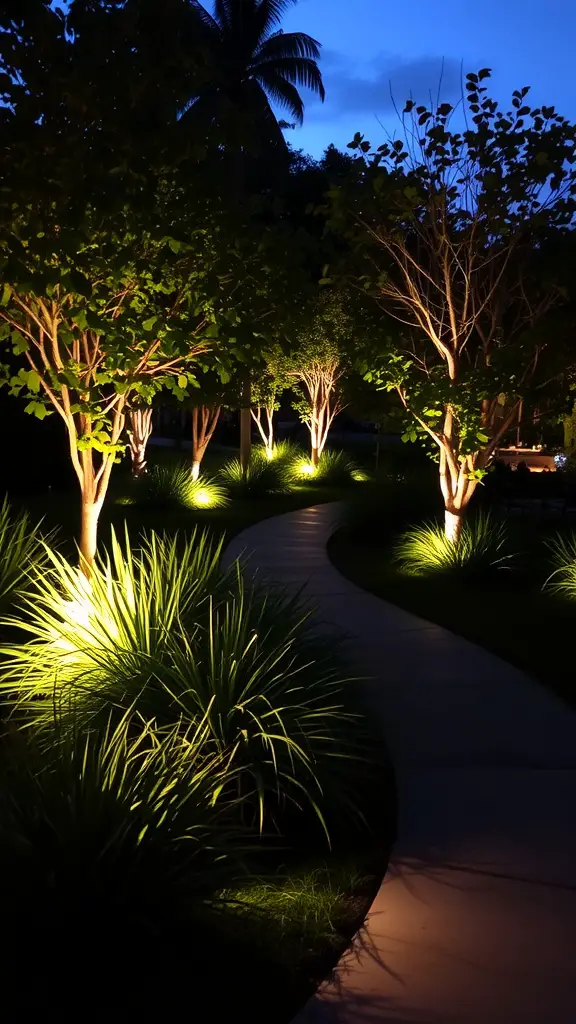
Lighting can completely change the feel of your outdoor space at night. The image shows a beautifully lit pathway surrounded by trees and lush greenery. Soft lights highlight the plants and create a warm, inviting atmosphere.
Using lights along pathways not only enhances safety but also adds a touch of elegance. The way the lights illuminate the trees and grass makes the area feel cozy and welcoming. It’s perfect for evening gatherings or simply enjoying a quiet night outside.
Consider using different types of lighting, like spotlights for trees and softer lights for the ground. This mix can create layers of light that add depth to your garden. You can also experiment with colors to match your mood or the season.
Overall, thoughtful lighting can transform your landscape into a magical evening retreat. It invites you to step outside and enjoy the beauty of your surroundings, even after the sun goes down.
Designing Child-Friendly Play Areas
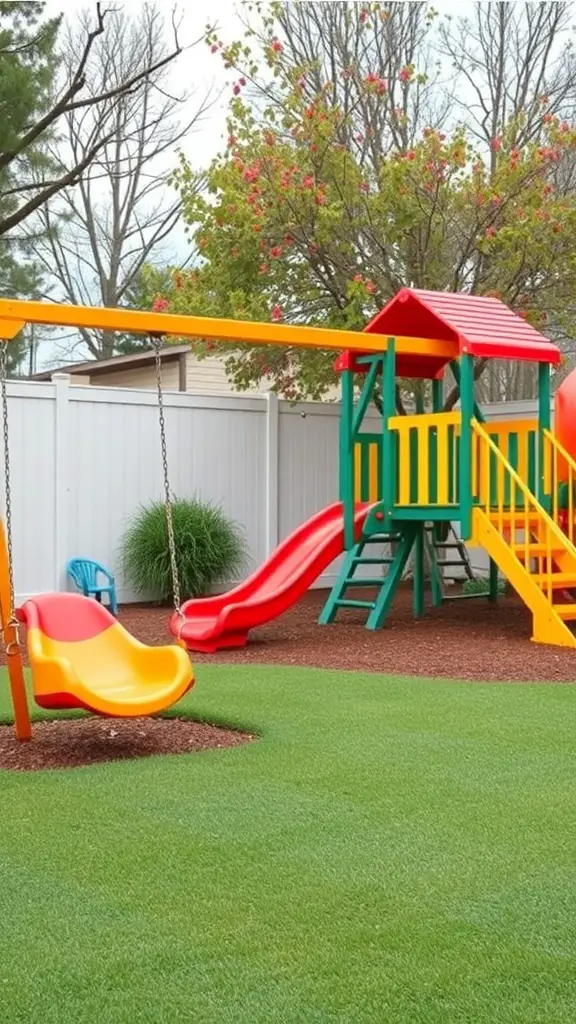
Creating a child-friendly play area is a fun way to enhance your outdoor space. The image shows a vibrant playground with swings, a slide, and a climbing structure. Bright colors like red, yellow, and green make it inviting for kids.
Safety is key when designing these areas. Soft surfaces, like grass or mulch, help cushion falls. The playground equipment should be sturdy and age-appropriate. This setup encourages kids to explore and be active.
Incorporating seating for parents is a great idea too. A simple chair nearby allows adults to relax while keeping an eye on the little ones. Adding some greenery around the play area can create a pleasant environment.
Overall, a well-designed play area not only provides fun but also promotes physical activity and social interaction among children.
Designing a Cozy Outdoor Dining Area
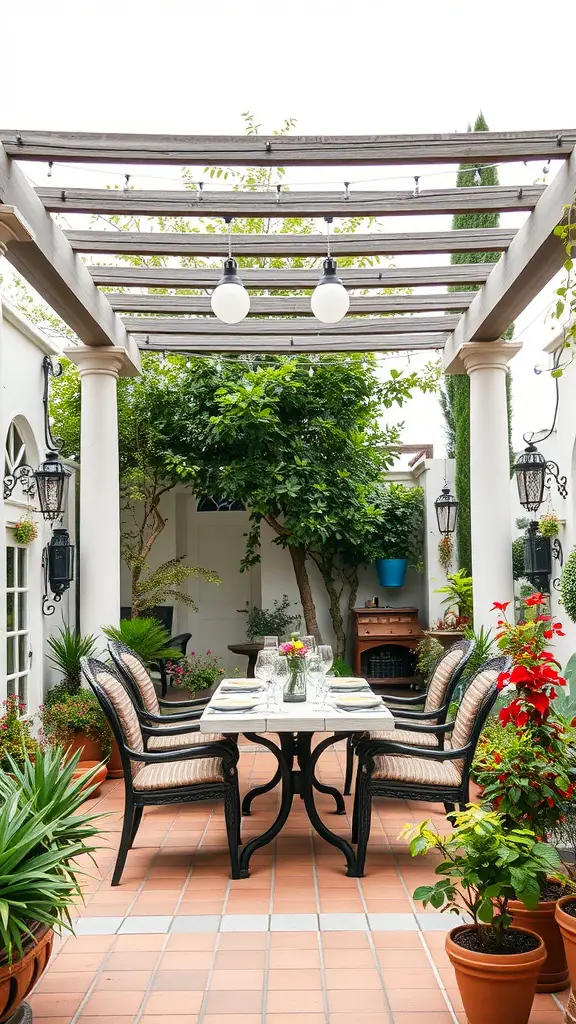
Creating a cozy outdoor dining area can transform your backyard into a delightful retreat. The image showcases a charming setup with a beautiful table and comfortable chairs, perfect for enjoying meals with family and friends.
The pergola overhead adds a nice touch, providing some shade while still allowing natural light to filter through. This makes it an inviting spot for both daytime brunches and evening dinners. String lights can enhance the atmosphere, making the space feel warm and welcoming.
Surrounding the dining area, you’ll notice vibrant plants in pots. These not only add color but also create a sense of privacy. Incorporating greenery can make the space feel more connected to nature, enhancing the overall experience.
Consider adding personal touches like decorative tableware or a small centerpiece of fresh flowers. These details can make your outdoor dining area feel special and tailored to your style. Whether it’s a casual lunch or a festive dinner, this setup is sure to impress.
Creating Privacy with Hedges and Fencing
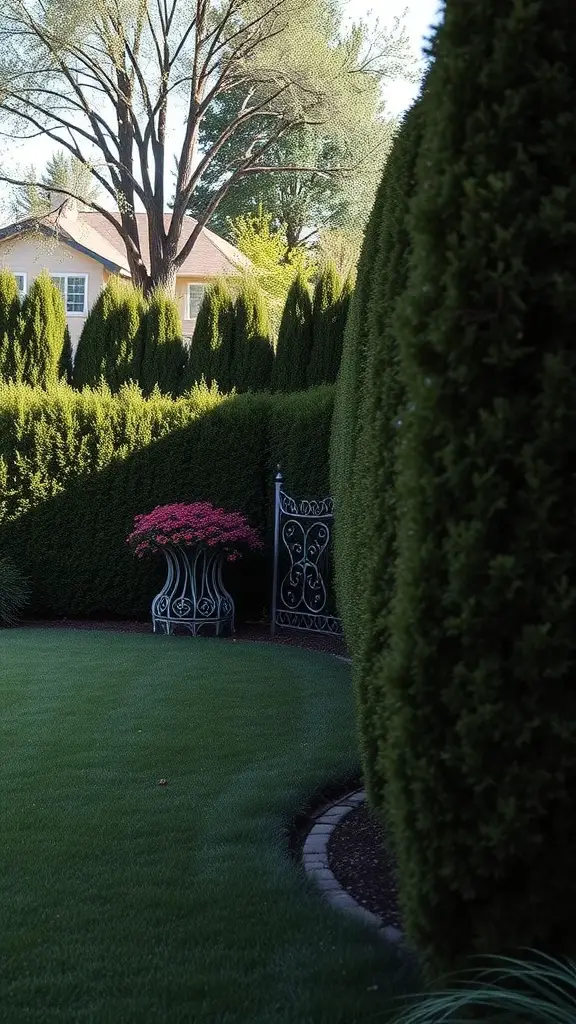
Creating a private space in your yard can be a simple yet effective way to enhance your outdoor experience. The image shows a beautifully manicured garden with tall hedges that provide a natural barrier. These hedges not only block the view from neighbors but also add a lush, green feel to the area.
The use of fencing, like the ornate gate seen in the picture, can complement the hedges. It adds a touch of elegance while keeping your space secure. The combination of greenery and structured fencing creates a cozy nook perfect for relaxation or entertaining guests.
Incorporating colorful elements, such as the pink flowers in the garden, can further enhance the privacy features. They draw the eye and soften the overall look. This blend of plants and fencing can transform any yard into a peaceful retreat.
Using Hardscaping Elements for Structure
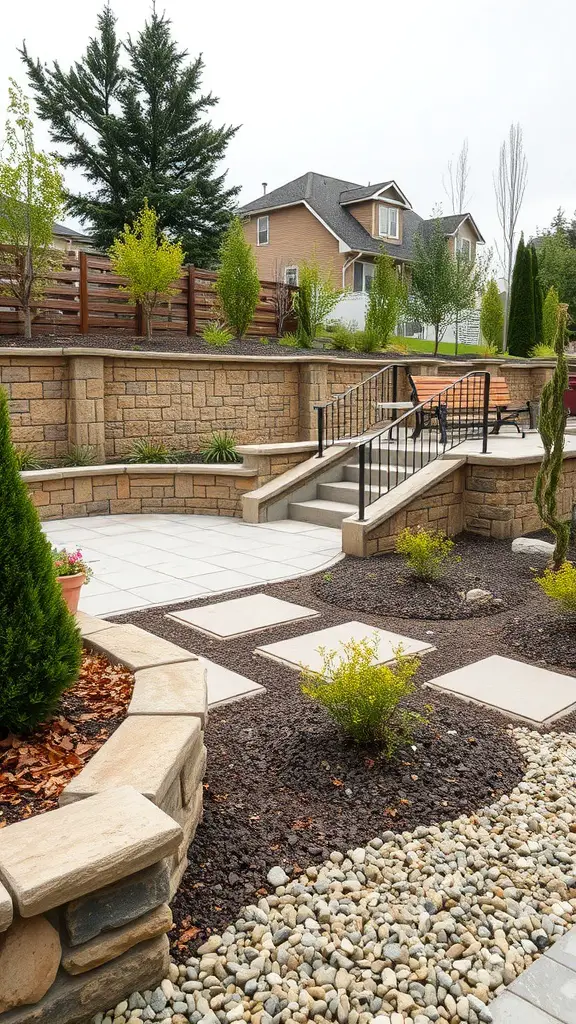
Hardscaping is a fantastic way to add structure to your outdoor space. In the image, you can see a well-designed landscape featuring various hardscaping elements. The stone walls and pathways create defined areas, making the space feel organized and inviting.
The use of materials like stone and concrete not only adds durability but also enhances the visual appeal. Notice how the steps lead up to a cozy seating area, perfect for relaxation or gatherings. This setup encourages outdoor living and makes the yard more functional.
Plants and greenery complement the hardscaping beautifully. They soften the edges and add a splash of color, creating a balanced look. The combination of hard and soft elements is key to a successful landscape design.
When planning your own space, think about how hardscaping can help define areas for different activities. Whether it’s a patio for dining or a pathway for strolling, these elements can guide movement and enhance the overall experience of your yard.
Creating a Butterfly and Pollinator Garden
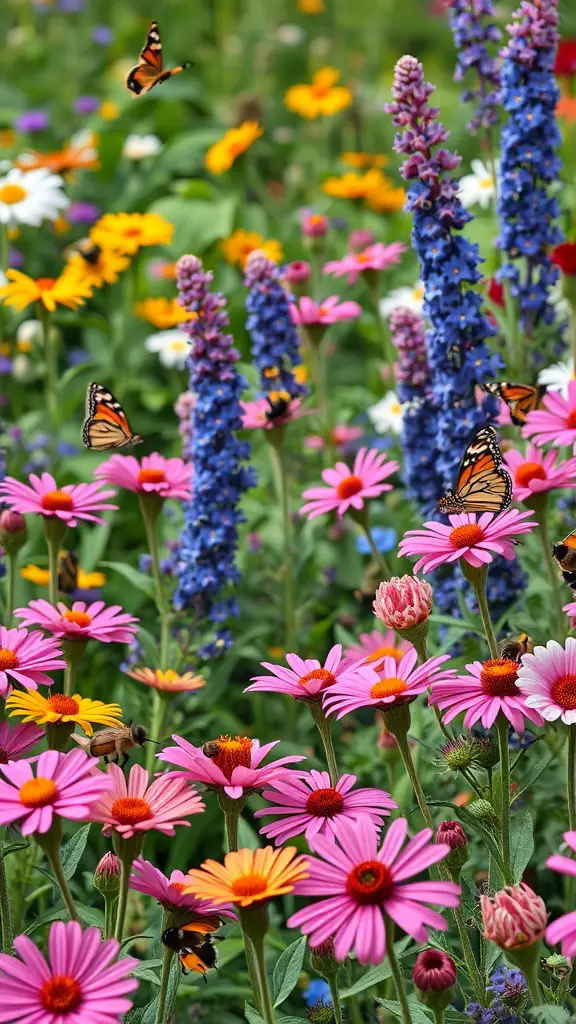
Creating a butterfly and pollinator garden is a delightful way to invite nature into your space. The image showcases a vibrant mix of flowers, attracting butterflies and bees. The colorful blooms, including pink daisies and tall blue flowers, create a lively scene that is both beautiful and beneficial.
To start your garden, choose a variety of native plants. These plants are well-suited for your local climate and will thrive with minimal care. Flowers like coneflowers, asters, and zinnias are excellent choices. They not only look stunning but also provide food for butterflies and other pollinators.
Consider the layout of your garden. Grouping plants in clusters makes it easier for pollinators to find food. Ensure there are blooms from spring to fall to keep your garden buzzing with activity all season long. Adding a shallow water source can also help attract more wildlife.
Don’t forget to avoid pesticides, as they can harm beneficial insects. Instead, focus on creating a healthy ecosystem. With a little planning, your garden can become a haven for butterflies and bees, bringing joy and beauty to your outdoor space.
Utilizing Garden Sculptures and Art
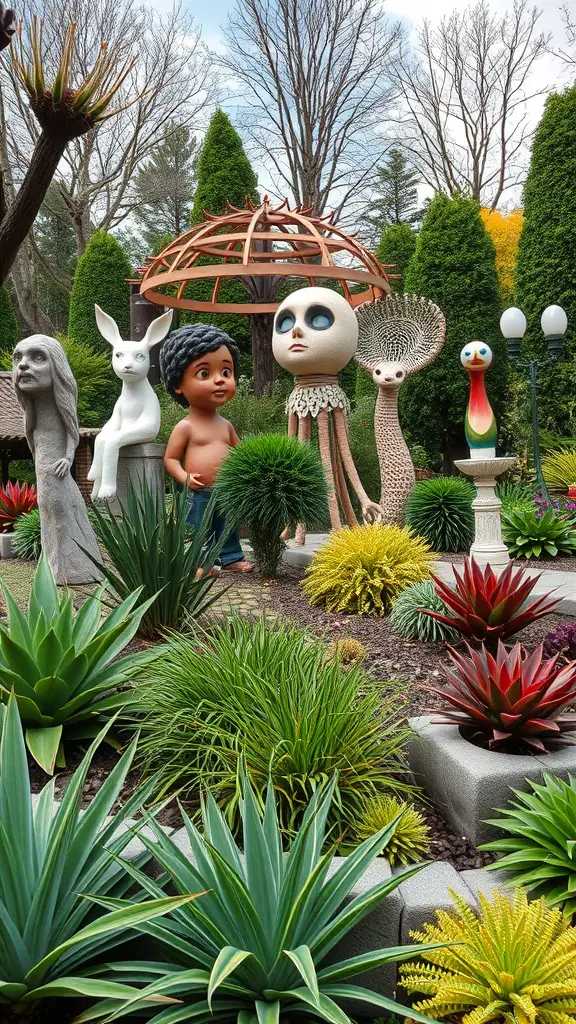
Garden sculptures and art can bring a unique flair to any outdoor space. The image showcases a vibrant garden filled with various sculptures, each adding character and charm. From whimsical figures to abstract designs, these pieces serve as focal points that draw the eye and spark conversation.
The playful arrangement of sculptures, including a friendly-looking boy and a curious rabbit, creates a sense of wonder. The mix of textures and colors in the plants surrounding them enhances the visual appeal. This combination of art and nature invites visitors to explore and enjoy the garden.
Incorporating sculptures into your garden design can transform a simple landscape into an engaging environment. Whether you prefer classic statues or modern art, the key is to choose pieces that resonate with your personal style. This not only beautifies your space but also reflects your personality.
Incorporating Fire Pits for Gatherings
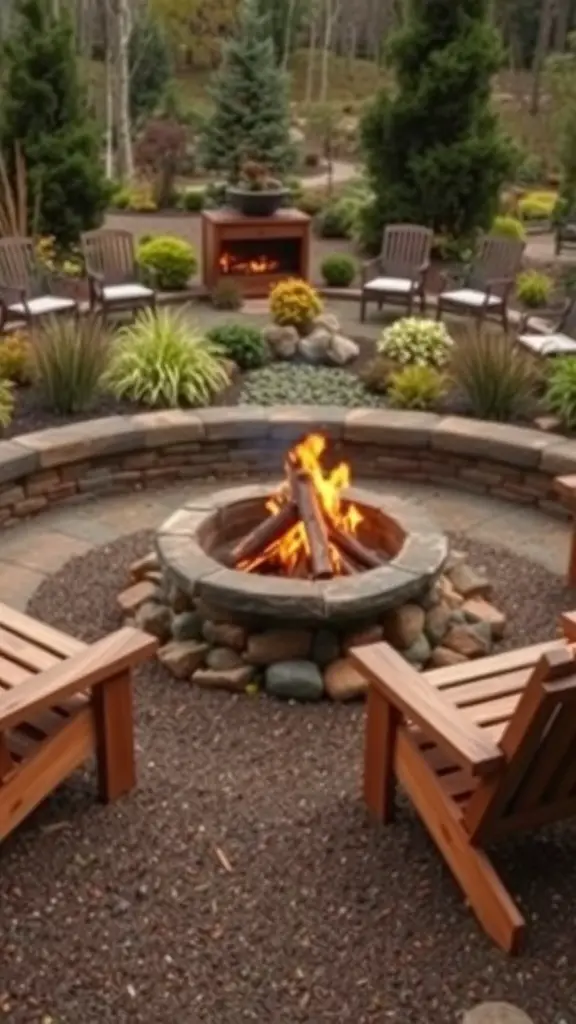
Fire pits are a fantastic addition to any outdoor space. They create a cozy spot for friends and family to gather. The image shows a beautifully designed fire pit area surrounded by comfortable seating. This setup invites everyone to relax and enjoy the warmth of the fire.
The circular arrangement of chairs around the fire pit encourages conversation. It’s a perfect spot for roasting marshmallows or sharing stories under the stars. The surrounding greenery adds a nice touch, making the area feel inviting and serene.
When planning your fire pit area, think about the materials you want to use. Stone and wood are popular choices that blend well with nature. You can also add some decorative plants or flowers to enhance the look. Lighting is another key element. Soft lights can create a magical atmosphere as the sun sets.
Overall, a fire pit can transform your outdoor space into a gathering place. It’s not just about warmth; it’s about creating memories with loved ones. So, gather your friends, grab some blankets, and enjoy the great outdoors!
Incorporating Green Roofs for Urban Spaces
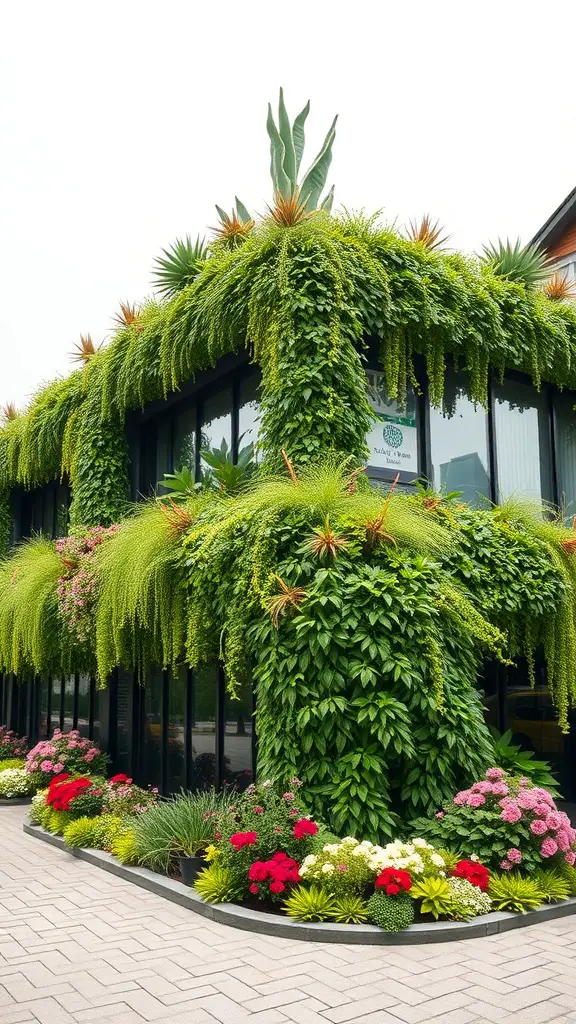
Green roofs are a fantastic way to bring nature into urban settings. They not only look great but also provide numerous benefits. The image shows a building adorned with lush greenery, showcasing how plants can transform a simple structure into a vibrant oasis.
These roofs help improve air quality and reduce heat, making cities more livable. The cascading plants in the image create a beautiful visual effect, drawing attention and inspiring others to consider similar designs.
Incorporating various plant types can enhance biodiversity and attract pollinators. The colorful flowers at the base of the building add a cheerful touch, making the space inviting for both residents and visitors.
Green roofs also offer insulation, helping to regulate indoor temperatures. They can be a great way to utilize unused spaces, turning rooftops into gardens or relaxation areas. This image perfectly illustrates how urban spaces can be reimagined with a little creativity and greenery.
Utilizing Colorful Containers for Versatility
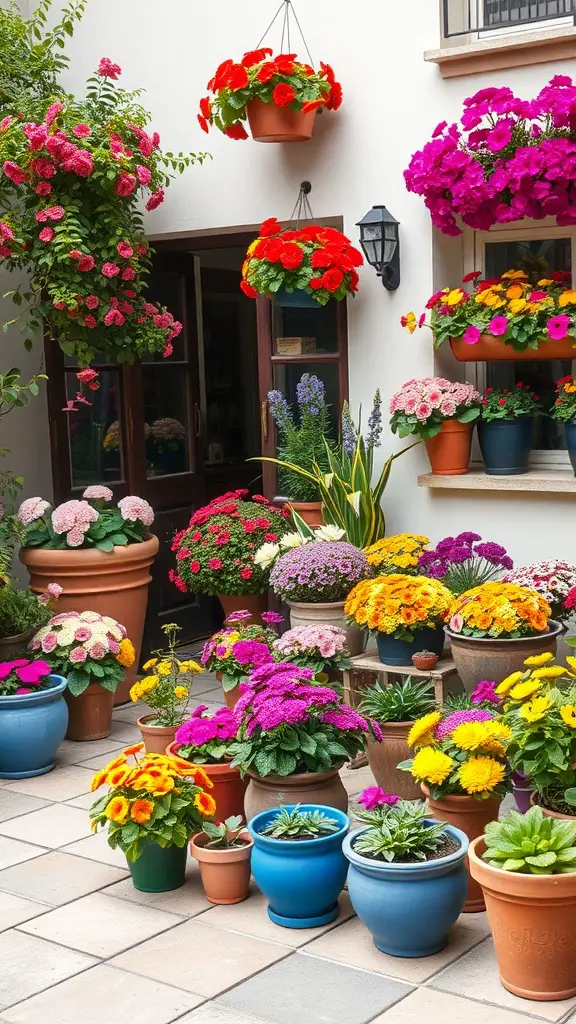
Colorful containers can transform any outdoor space into a lively retreat. The image showcases a vibrant array of flowers in various pots, creating a cheerful atmosphere. Each container adds a splash of color, making the area feel welcoming and warm.
Mixing different shapes and sizes of pots can enhance visual interest. Notice how the hanging pots complement the ones on the ground. This layering effect draws the eye and creates depth in your garden design.
Choosing seasonal flowers allows for versatility. You can easily swap out plants to match the changing seasons or your mood. This flexibility keeps your space fresh and exciting throughout the year.
Don’t shy away from experimenting with color combinations. Bright yellows, deep purples, and soft pinks can work together beautifully. The key is to find a balance that feels right for your space.
Lastly, remember that containers are not just for flowers. Herbs, succulents, and even small shrubs can thrive in pots. This versatility makes it easy to personalize your garden, no matter the size.

